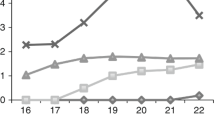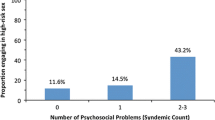Abstract
Young men who have sex with men are substantially impacted by HIV/AIDS, and most new infections occur in serious romantic dyads. Young people experience substantial psychosocial and neurocognitive change between adolescence and emerging adulthood which impacts engagement in risk behaviors. We aimed to examine developmental change in the association between sexual partnership characteristics and condomless anal intercourse (CAI). Data were taken from an analytic sample of 114 young adult MSM from a longitudinal study of lesbian, gay, bisexual and transgender youth with 4-year follow-up. Rates of CAI were approximately 12 times higher in serious compared to casual partnerships, but this effect diminished in size over time. Partner age differences and violence were associated with more CAI, and these associations strengthened across development. Characteristics of serious relationships (e.g., power dynamics) were also examined. We discuss the need for HIV prevention strategies that address dyadic influences on CAI during this critical developmental period.

Similar content being viewed by others
References
Centers for Disease Control and Prevention. Diagnoses of HIV infection in the United States and dependent areas, 2011. HIV Surveillance Report. vol. 23, 2013.
Prejean J, Song R, Hernandez A, et al. Estimated HIV incidence in the United States, 2006-2009. PLoS One. 2011;6:e17502.
Sullivan PS, Salazar L, Buchbinder S, Sanchez TH. Estimating the proportion of HIV transmissions from main sex partners among men who have sex with men in five US cities. AIDS. 2009;23:1153–62.
Mustanski B, Parsons JT. Introduction to the special section on sexual health in gay and bisexual male couples. Arch Sex Behav. 2014;43:17–9.
Mustanski BS, Newcomb ME, Du Bois SN, Garcia SC, Grov C. HIV in young men who have sex with men: a review of epidemiology, risk and protective factors, and interventions. J Sex Res. 2011;48:218–53.
Crepaz N, Marks G, Mansergh G, et al. Age-related risk for HIV infection in men who have sex with men: examination of behavioral, relationship, and serostatus variables. AIDS Educ Prev. 2000;12:405–15.
Dudley MG, Rostosky SS, Korfhage BA, Zimmerman RS. Correlates of high-risk sexual behavior among young men who have sex with men. AIDS Educ Prev. 2004;16:328–40.
Hays RB, Kegeles SM, Coates TJ. Unprotected sex and HIV risk taking among young gay men within boyfriend relationships. AIDS Educ Prev. 1997;9:314–29.
Mustanski B, Newcomb ME, Clerkin EM. Relationship characteristics and sexual risk-taking in young men who have sex with men. Health Psychol. 2011;30:597–605.
Newcomb ME, Ryan DT, Garofalo R, Mustanski B. The effects of sexual partnership and relationship characteristics on three sexual risk variables in young men who have sex with men. Arch Sex Behav. 2014;43:61–72.
Greene GJ, Andrews R, Kuper L, Mustanski B. Intimacy, monogamy, and condom problems drive unprotected sex among young men in serious relationships with other men: a mixed methods dyadic study. Arch Sex Behav. 2014;43:73–87.
Centers for Disease Control and Prevention. HIV among gay, bisexual, and other men who have sex with men: Unites States Department of Health and Human Services, 2013.
Jessor R. Risk behavior in adolescence: a psychosocial framework for understanding and action. Dev Rev. 1992;12:374–90.
Arnett JJ. Emerging adulthood. A theory of development from the late teens through the twenties. Am Psychol. 2000;55:469–80.
Centers for Disease Control and Prevention. Youth Risk Behavior Surveillance - United States, 2011. MMWR. 2012;61:1–162.
Steinberg L. A social neuroscience perspective on adolescent risk-taking. Dev Rev. 2008;28:78–106.
Corbin WR, Fromme K. Alcohol use and serial monogamy as risks for sexually transmitted diseases in young adults. Health Psychol. 2002;21:229–36.
Misovich SJ, Fisher JD, Fisher WA. Close relationships and elevated HIV risk behavior: evidence and possible underlying psychological processes. Rev Gen Psychol. 1997;1:72–107.
Robles TF, Kiecolt-Glaser JK. The physiology of marriage: pathways to health. Physiol Behav. 2003;79:409–16.
Waite LJ, Gallagher M. The case for marriage: why married people are happer, healthier, and better off financially: Doubleday Books, 2000.
House JS, Umberson D, Landis KR. Structures and processes of social support. Ann Rev Sociol. 1988;14:293–318.
Turner RJ, Brown RL. Social support and mental health. New York: Cambridge University Press; 2010.
Drasin H, Beals KP, Elliott MN, et al. Age cohort differences in the developmental milestones of gay men. J Homosex. 2008;54:381–99.
Eccles TA, Sayegh MA, Fortenberry JD, Zimet GD. More normal than not: a qualitative assessment of the developmental experiences of gay male youth. J Adolesc Health. 2004;35(425):e411–28.
Rosario M, Schrimshaw EW, Hunter J. Different patterns of sexual identity development over time: implications for the psychological adjustment of lesbian, gay, and bisexual youths. J Sex Res. 2011;48:3–15.
Rosario M, Schrimshaw EW, Hunter J. Predicting different patterns of sexual identity development over time among lesbian, gay, and bisexual youths: a cluster analytic approach. Am J Community Psychol. 2008;42:266–82.
Mustanski B, Birkett M, Greene GJ, Hatzenbuehler ML, Newcomb ME. Envisioning an America without sexual orientation inequities in adolescent health. Am J Public Health. 2014;104:218–25.
Macapagal KR, Greene GJ, Rivera Z, Mustanski B. Relationship stages and processes among same-sex couple in emerging adulthood. (under review).
Mustanski B, Newcomb ME. Older sexual partners may contribute to racial disparities in HIV among young men who have sex with men. J Adolesc Health. 2013;52:666–7.
Joseph HA, Marks G, Belcher L, et al. Older partner selection, sexual risk behaviour and unrecognised HIV infection among black and Latino men who have sex with men. Sex Transm Infect. 2011;87:442–7.
Newcomb ME, Mustanski B. Racial differences in same-race partnering and the effects of sexual partnership characteristics on HIV Risk in MSM: a prospective sexual diary study. J Acquir Immune Defic Syndr. 2013;62:329–33.
Centers for Disease Control and Prevention. Monitoring selected national HIV prevention and care objectives by using HIV surveillance data - United States and 6 U.S. dependent areas - 2010. HIV Surveillance Supplemental Report. 2012, 17
Berry M, Raymond HF, McFarland W. Same race and older partner selection may explain higher HIV prevalence among black men who have sex with men. AIDS. 2007;21:2349–50.
Dank M, Lachman P, Zweig JM, Yahner J. Dating violence experiences of lesbian, gay, bisexual, and transgender youth. J Youth Adolesc. 2014;43:846–57.
Buller AM, Devries KM, Howard LM, Bacchus LJ. Associations between intimate partner violence and health among men who have sex with men: a systematic review and meta-analysis. PLoS Med. 2014;11:e1001609.
Finneran C, Stephenson R. Intimate partner violence among men who have sex with men: a systematic review. Trauma Violence Abuse. 2013;14:168–85.
Finneran C, Stephenson R. Intimate partner violence, minority stress, and sexual risk-taking among U.S. men who have sex with men. J Homosex. 2014;61:288–306.
Feldman MB, Ream GL, Diaz RM, El-Bassel N. Intimate partner violence and HIV sexual risk behavior among Latino gay and bisexual men: the role of situational factors. J LGBT Health Res. 2007;3:75–87.
Houston E, McKirnan DJ. Intimate partner abuse among gay and bisexual men: risk correlates and health outcomes. J Urban Health. 2007;84:681–90.
Koblin BA, Torian L, Xu G, et al. Violence and HIV-related risk among young men who have sex with men. AIDS Care. 2006;18:961–7.
Mustanski B, Garofalo R, Herrick A, Donenberg G. Psychosocial health problems increase risk for HIV among urban young men who have sex with men: preliminary evidence of a syndemic in need of attention. Ann Behav Med. 2007;34:37–45.
Grov C, Breslow AS, Newcomb ME, Rosenberger JG, Bauermeister JA. Gay and bisexual men’s use of the Internet: research from the 1990s through 2013. J Sex Res. 2014;51:390–409.
Bauermeister JA, Leslie-Santana M, Johns MM, Pingel E, Eisenberg A. Mr. Right and Mr. Right Now: romantic and casual partner-seeking online among young men who have sex with men. AIDS Behav. 2011;15:261–72.
Downing MJ Jr. Using the internet in pursuit of public sexual encounters: is frequency of use associated with risk behavior among MSM? Am J Mens Health. 2012;6:18–27.
Garofalo R, Herrick A, Mustanski BS, Donenberg GR. Tip of the Iceberg: young men who have sex with men, the Internet, and HIV risk. Am J Public Health. 2007;97:1113–7.
Horvath KJ, Rosser BR, Remafedi G. Sexual risk taking among young internet-using men who have sex with men. Am J Public Health. 2008;98:1059–67.
Mustanski BS. Are sexual partners met online associated with HIV/STI risk behaviours? Retrospective and daily diary data in conflict. AIDS Care. 2007;19:822–7.
Ogilvie GS, Taylor DL, Trussler T, et al. Seeking sexual partners on the internet: a marker for risky sexual behaviour in men who have sex with men. Can J Public Health. 2008;99:185–8.
Newcomb ME, Mustanski B. Developmental change in the relationship between alcohol and drug use before sex and sexual risk behavior in young men who have sex with men. AIDS Behav. 2014;18:1981–90.
Tonry M, Ohlin LE, Farrington DP. Human development and criminal behavior: New ways of advancing knowledge. New York: Springer-Verlag Publishing; 1991.
Heckathorn DD. Respondent-driven sampling: a new approach to the study of hidden populations. Soc Probl. 1997;44:174–200.
Mustanski B, Starks T, Newcomb ME. Methods for the design and analysis of relationship and partner effects on sexual health. Arch Sex Behav. 2014;43:21–33.
Pulerwitz J, Gortmaker SL, DeJong W. Measuring sexual relationship power in HIV/STD research. Sex Roles. 2000;42:637–60.
Raudenbush SW, Bryk AS, Cheong YF, Congdon RT, du Toit M. HLM 7: Hierarchical linear and nonlinear modeling. Chicago: Scientific Software International; 2011.
Mustanski B, Rendina HJ, Greene GJ, Sullivan PS, Parsons JT. Testing negative means i’m lucky, making good choices, or immune: diverse reactions to HIV test results are associated with risk behaviors. Ann Behav Med. 2014;48:371–83.
Newcomb ME, Heinz AJ, Mustanski B. Examining risk and protective factors for alcohol use in lesbian, gay, bisexual, and transgender youth: a longitudinal multilevel analysis. J Stud Alcohol Drugs. 2012;73:783–93.
Acknowledgments
This research was supported by a Grant from the National Institute of Mental Health (R21MH095413; PI: Mustanski), National Institute on Drug Abuse (U01DA036939), an American Foundation for Suicide Prevention grant (PI: Mustanski), the William T. Grant Foundation Scholars Award (PI: Mustanski), and the David Bohnett Foundation (PI: Mustanski). The content is solely the responsibility of the authors and does not necessarily represent the official views of the funding agencies.
Author information
Authors and Affiliations
Corresponding author
Rights and permissions
About this article
Cite this article
Newcomb, M.E., Mustanski, B. Developmental Change in the Effects of Sexual Partner and Relationship Characteristics on Sexual Risk Behavior in Young Men Who Have Sex with Men. AIDS Behav 20, 1284–1294 (2016). https://doi.org/10.1007/s10461-015-1046-6
Published:
Issue Date:
DOI: https://doi.org/10.1007/s10461-015-1046-6




